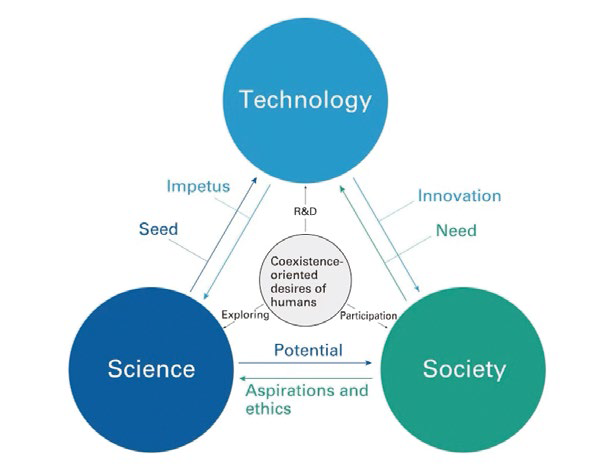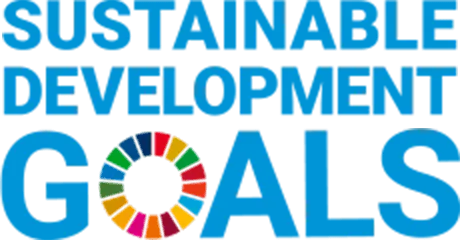Inochi Declaration
Aim for new forms of wealth based on value metrics that awaken the desire for symbiosis, ensuring the sustainable circulation and regeneration of the Inochi that embraces both humanity and the artifacts we create.
The affluence brought by industrial society has been achieved under an economic system based on the spiral-up of production and consumption: producing goods that enhance people’s lives at lower cost, selling them in greater quantities, thereby increasing revenues and raising incomes, which in turn stimulates further consumption. Throughout this process, countless forms of Inochi nurtured by the Earth and the mechanisms that sustain them have been continuously extracted and consumed. However, today, the scale of this system’s force has grown to surpass the regenerative capacity of the planet’s Inochi*1.
For this reason, transforming our economic system is one of the critical imperatives of the Inochi Declaration, and to achieve this, we must redefine our metrics of wealth.
Instead of directing human growth ambitions solely toward competition based on material and monetary “quantitative economic indicators,” we must foster a new orientation— one that awakens humanity’s inherent desire for mutual aid and sustainability—guided by value metrics aimed at the regeneration, nurturing, and circulatory viability of Inochi, including human life itself.
To drive such social transformation, we can utilize future diagrams based on the SINIC Theory—a future forecasting theory*2. This theory was presented around the time of the Expo 1970 in Osaka by Kazuma Tateishi, the founder of OMRON. Today, not only OMRON but also many young entrepreneurs, executives of large corporations, and national and local governments are increasingly resonating with and applying this model.


Left: SINIC Theory Science, Technology and Society Diagram, Right: The Basic Model of SINIC Theory
The SINIC Theory is characterized by its approach of retracing a million years of human history and predicting future societies based on the cyclical interactions among science, technology, and society. According to the theory, we are now at the “Optimization Society” stage—a major transition from the Industrial and Information Societies, which emphasized individual and material values, toward the “Autonomous Society” and “Natural Society,” where the heart and community are revalued, ushering in new forms of affluence. Achieving autonomy requires setting a course toward decentralized networked societies, value creation through regeneration, and ethical capitalism, while developing new value metrics and economic systems.
In this context, the twin driving forces for the economic systems leading toward the future are envisioned as the “Regenerative Economy” and “Ethical Capitalism”.
The first, “Regenerative”*3, is often misunderstood as synonymous with circular economy or sustainability. Originally, the term referred to agriculture that revitalizes degraded soils and restores diminished wildlife and plant species while producing food. Extending this concept beyond material and resource recycling and ecosystem restoration, the regenerative economy envisions economic activities that treat society as a living collective and support the regeneration of various forms of degraded Inochi—an economy that enables every Inochi to unleash its radiant light.
The second, “Ethical Capitalism”, is a management philosophy where the purpose of business is good deeds, and the profits gained are invested in further good deeds. This concept resonates with traditional Japanese commercial ethics, such as the Sanpo Yoshi (good for the seller, buyer, and society) philosophy of the Omi merchants and Eiichi Shibusawa’s principles of balancing The Analects and Abacus. It aligns with contemporary ideas such as Markus Gabriel’s “Ethical Capitalism” and Tomonobu Imamichi’s “Ecoethica” (Ecological Ethics)*4. The emerging trend of social entrepreneurship—businesses that integrate good deeds into their models—is directly linked to supporting the next generation’s efforts to build a better future.
Aiming to foster a society where future generations can unleash their Inochi and engage in the creation of a better world, the Human Renaissance Institute—a frontier institution of OMRON—has since the 1990s pursued initiatives aimed at realizing a decentralized networked society, the utilization of untapped resources, enhancement of agricultural values, and the extension of healthy life expectancy. Today, we continue to co-create new approaches such as ridesharing, remote diagnostics, and health-oriented management.
The Inochi Forum, in collaboration with the Human Renaissance Institute and other organizations, will contribute to developing new value indicators that awaken the desire for symbiosis and help open pathways toward a future where every Inochi unleashes its radiant light.
[Notes]
*1 Global evidence on planetary limits and environmental degradation:
https://www.nature.com/articles/s41467-023-39810-w
*2 OMRON Corporation, SINIC Theory:
https://www.omron.com/jp/ja/about/corporate/vision/sinic/theory.html
*3 Explanation of regenerative economy (video):
https://youtu.be/oZ-KyYnQhPw?feature=shared
*4 Tomonobu Imamichi, Ecoethica:
https://opac.ll.chiba-u.jp/da/curator/900040690/42imamichi.pdf
[Action Platform]
Economy, Employment and Poverty
[SDGs]



